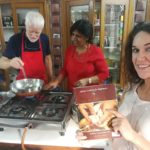Jodhpur to Udaipur – 254 km (by car)
& 25289 Fit Bit steps
Our road trip across the Aravali Hills to Udaipur was not at all relaxing as the driver ignored our requests to drive more slowly (“I don’t like to follow”, he said, somewhat apologetically), and talked on his cell phone continuously, which meant no hands on the wheel when he changed gears! Luckily, we were able to break the journey at the Chaumukha Mandir Jain temple in Ranakpur. This magnificent 15th C structure, which is a place of pilgrimage for the Jains, includes domes, shiksra, cupolas, turrets and 1444 marble pillars, none of which are alike. Relieved to arrive in Udaipur, we promptly fled the vehicle when our driver was flummoxed with a one-way system near our guesthouse!
Also known as the “City of the lakes”, Udaipur sits on the edge of Lake Picola, one of a series of interconnected artificial lakes, created between the 15th and 19th C by building dams primarily to meet the drinking water and irrigation needs of the city and its neighborhood. Founded in 1559 by Maharana Udai Singh II as the new capital of the Mewar kingdom, Udaipur is overlooked by the imposing City Palace, Rajasthan’s largest palace. We spent a long time exploring many of its constituent palaces, which are joined by zigzag corridors and surround quadrangles and courtyards. On a pleasant sunset cruise, we could see the extent of the huge City Palace complex. The cruise also took us past the 18thC Lake Palace (now a hotel) and the 16thC Jag Mandir Palace.
A highlight of our stay in Udaipur was a cooking class conducted in our guesthouse by Sushma, a well-known local teacher of typical Indian home cuisine. Also co-owner of the Krishna Niwas Guesthouse with her artist/art dealer spouse, Sushma has been conducting cooking classes for a decade. Her first book on the basics of the best of Indian cuisine has just been published. In the purpose-built modern kitchen, with the assistance of her daughter, who is just beginning a PhD in neuropsychology, Sushma demonstrated how to cook various vzgetarian dishes and then involved us in preparing (and eating!) them. These included butter paneer masala, dal makhani, jeera aloo, naan and chipati. Also taking the class were two delightful travellers from Ireland with whom we later went for a drink. Lara was soon heading home to Dublin, while Cian was going on to a ten-day meditation retreat, where silence is the rule (and no books or internet). We discussed the possibility of meeting up with Cian in February when he will be joining his parents for an organized tour of southern India.
We also attended an evening performance of traditional dancing and puppetry at the Bagore Ki Haveli. This is a highly popular event frequented by tourists, the majority of which appeared to be Indian. Afterwards, Paul realized he had left his prescription sunglasses on the sunset cruise boat. The ferry office was closed by that time, but a night watchman who offered to call the company for us, was told they would look for the glasses the following morning. As we were taking a train just after midnight, we enlisted the help of hotel as well. When we arrived in Jaipur, Paul received a voicemail to say that the glasses had been found, the hotel owner ensured that they were picked up and a day and a half later the glasses were delivered to our guesthouse in Jaipur. The hotel refused to accept any payment. If anyone visits Udaipur please patronize the Krishna Niwas Guesthouse!













